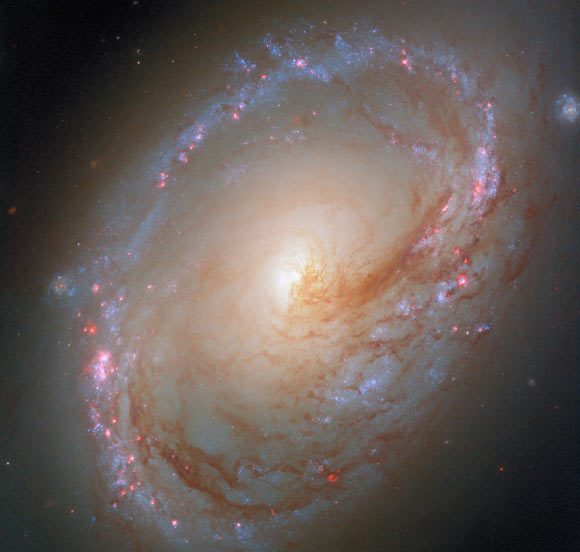Astronomers using the NASA/ESA Hubble Space Telescope have produced a spectacularly detailed image of the asymmetric spiral galaxy Messier 96.
This Hubble image shows Messier 96, a spiral galaxy some 34 million light-years away in the constellation of Leo. Image credit: NASA / ESA /Hubble / F. Belfiore / D. Calzetti.
Messier 96 is a spiral galaxy located in the constellation of Leo, about 34 million light-years from Earth.
The galaxy was first discovered by French astronomer Pierre Méchain on March 20, 1781, and added to Charles Messier’s catalogue of astronomical objects just four days later.
Also known as NGC 3368, LEDA 32192 or M96, it spans about 100,000 light-years across — about the size of our Milky Way Galaxy — and has an estimated mass of 80 billion solar masses.
Messier 96 is a dominant member of the Leo I galaxy group, also called the M96 group.
The group also includes Messier 95, Messier 105 as well as a number of fainter galaxies, and is the nearest group containing both bright spiral galaxies and a bright elliptical galaxy.
Messier 96 resembles a giant maelstrom of glowing gas, rippled with dark dust that swirls inwards towards the nucleus.
It’s a very asymmetric galaxy; its dust and gas is unevenly spread throughout its weak spiral arms, and its core is not exactly at the galactic center.
Its arms are also asymmetrical, thought to have been influenced by the gravitational pull of other galaxies within the Leo I group.
“The gravitational pull of its galactic neighbors may be responsible for Messier 96’s uneven distribution of gas and dust, asymmetric spiral arms, and off-center galactic core,” the Hubble astronomers said in a statement.
“This asymmetric appearance is on full display in a new Hubble image, which incorporates observations made in ultraviolet and optical light.”
“Hubble images of Messier 96 have been released previously in 2015 and 2018,” they added.
“Each successive image has added new data, building up a beautiful and scientifically valuable view of the galaxy.”
“This third version gives an entirely new perspective on Messier 96’s star formation.”
“The bubbles of pink gas in this image surround hot, young, massive stars, illuminating a ring of star formation in the outskirts of the galaxy.”
“These young stars are still embedded within the clouds of gas from which they were born.”
“The new data included for the first time in this image will be used to study how stars are born within giant dusty gas clouds, how dust filters starlight, and how stars affect their environments.”
